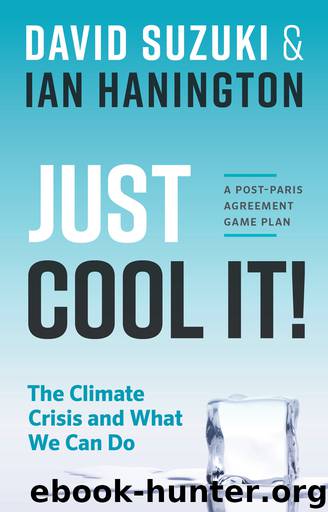Just Cool It! by David Suzuki

Author:David Suzuki
Language: eng
Format: epub
Publisher: Greystone Books
Published: 2017-03-22T04:00:00+00:00
Chapter 6
TECHNOLOGICAL SOLUTIONS
ABUNDANT, CHEAP FOSSIL fuels have driven explosive technological, industrial, and economic expansion for more than a century. The pervasive infrastructure developed to accommodate this growth makes it difficult to contemplate rapidly shifting away from coal, oil, and gas, which creates a psychological barrier to rational discourse on energy issues.
The ecological and true economic costs of energy use force us to scrutinize our way of living. And because our infrastructure doesn’t allow us to entirely avoid fossil fuels, we must face the contradiction between how we should live and constraints against doing so.
Sustainability requires conserving energy and producing what we require with minimal ecological upset. Yet the inability to consider the need to shift quickly from fossil fuels means governments and industry look to mega-technologies such as carbon capture and storage, or CCS, to justify inaction on reducing greenhouse gas emissions, while dismissing solar and wind as impractical, too expensive, or unable to meet energy needs. Nuclear power may be an alternative to fossil fuels, but it’s extremely expensive and would not be online were it not for enormous subsidies. Nuclear fuel is also finite, so costs will rise while the problem of radioactive-waste disposal remains unsolved. These large-scale solutions also tend to concentrate power in the hands of governments and wealthy corporations, as they require massive investment, central planning, and, often, intensive security measures.
You’ve probably heard many arguments against shifting to clean energy: wind doesn’t always blow, sun doesn’t always shine, the technology’s not advanced enough, installations take up too much space, renewable energy is too intermittent and difficult to integrate into a system that relies on baseload (power that always runs) that can only come from fossil fuels, nuclear power, or large-scale hydro. And so we carry on, rushing to squeeze every last drop of oil and gas from the ground, using increasingly difficult and destructive methods such as fracking, deep-sea drilling, and oil sands extraction, with seemingly little concern for what we’ll do after we’ve burned it all. But many of these issues are engineering problems rather than renewable energy issues. Surely if we can split atoms for energy we can find a way to deal with cloudy skies.
A lot of research, including some by the David Suzuki Foundation, working with the Trottier Energy Futures Project, is also challenging those skeptical assumptions. “Canada has vast renewable energy resources in the form of hydropower, solar, wind energy, and biomass, as well as geothermal, wave, and tidal resources that are many times larger than current or projected levels of total fuel and electricity consumption,” a 2013 Trottier report, An Inventory of Low-Carbon Energy for Canada, concluded.1
Those findings are confirmed by research and experience elsewhere in the world. A 2013 study by engineers at Stanford University reported, “It is technically and economically feasible to convert New York’s all-purpose energy infrastructure to one powered by wind, water and sunlight,” and doing so “shows the way to a sustainable, inexpensive and reliable energy supply that creates local jobs and saves the state billions of dollars in pollution-related costs.
Download
This site does not store any files on its server. We only index and link to content provided by other sites. Please contact the content providers to delete copyright contents if any and email us, we'll remove relevant links or contents immediately.
The Lonely City by Olivia Laing(4569)
Animal Frequency by Melissa Alvarez(4150)
All Creatures Great and Small by James Herriot(3986)
Walking by Henry David Thoreau(3681)
Exit West by Mohsin Hamid(3634)
Origin Story: A Big History of Everything by David Christian(3472)
COSMOS by Carl Sagan(3348)
How to Read Water: Clues and Patterns from Puddles to the Sea (Natural Navigation) by Tristan Gooley(3240)
Hedgerow by John Wright(3106)
How to Do Nothing by Jenny Odell(3102)
The Inner Life of Animals by Peter Wohlleben(3099)
How to Read Nature by Tristan Gooley(3079)
Project Animal Farm: An Accidental Journey into the Secret World of Farming and the Truth About Our Food by Sonia Faruqi(3018)
Origin Story by David Christian(2992)
Water by Ian Miller(2953)
A Forest Journey by John Perlin(2916)
The Plant Messiah by Carlos Magdalena(2747)
A Wilder Time by William E. Glassley(2690)
Forests: A Very Short Introduction by Jaboury Ghazoul(2671)
